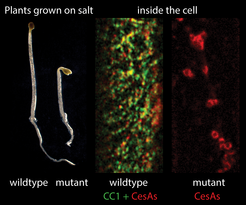Even plants can be stressed
Researchers identify proteins that allow plants to grow better under salt stress.
Plants need to make more and bigger cells if they want to grow and develop. Unlike animal cells, plant cells are surrounded by a cellular exoskeleton, called cell walls which direct plant growth and protect the plant against diseases. Importantly, most of the plants biomass is made up of the cell wall with cellulose being the major component. Hence, plant growth largely depend on the ability of plants to produce cell walls and cellulose, also under stress conditions, and it is therefore no surprise that research on cell wall biosynthesis is of high priority.
Previous studies of Dr. Staffan Persson’s research group and others have shown that the cellulose producing protein complex, called cellulose synthase, interacts with, and is guided by, an intracellular polymer structure, called microtubules. This interaction is important for shape and stability of plant cells.
The current research revealed that a previously unknown family of proteins supports the cellulose synthase machinery under salt stress conditions, and was named “Companions of Cellulose synthase (CC). “We show that these proteins, which we called CC proteins, are part of the cellulose synthase complex during cellulose synthesis”, said Staffan Persson.

Effect of salt stress on plants
Left panel (plants grown on salt): Plants with CC proteins (wild type) grow better on salt containing media than mutant plants, missing the CC genes
Right panel (inside the cell): A view inside he cell under salt stress; plants with CC proteins (wild type) show functional cellulose synthase complexes in the plasma membrane; Plants without CC proteins (mutant) show internalized cellulose synthase complexes which are not active anymore.
CC-proteins shown in green, cellulose synthase complexes are shown in red
The researchers discovered that the CC gene activity was increased when plants were exposed to high salt concentrations. Thus, the research team hypothesized an involvement of these proteins in salt tolerance of plants.
“To prove this hypothesis we deleted multiple genes of the CC gene family in the model plant Arabidopsis thaliana (thale cress), and grew the plants on salt-containing media. These mutated plants performed much worse than the wild-type plants”, explains Christopher Kesten, PhD student in Dr. Persson’s research group, and co-first author of this study. „In an additional step, we made fluorescent versions of the CC proteins and observed, with the help of a special microscope, where and how they function. It was quite a surprise to see that they were able to maintain the organization of microtubules under salt stress. This function helped the plants to maintain cellulose synthesis during the stress“, adds Dr. Anne Endler, also co-first author of this study.
The research group demonstrated that while the control plants could maintain their microtubules intact, the plants lacking the CC activity were unable to do so. This loss in microtubule function led to a failure in maintaining cellulose synthesis, which explained the reduction in plant growth on salt. These results therefore provide a mechanism for how the CC proteins aid plant biomass production under salt stress.
The group’s discovery of the CC proteins could promote future generation of salt tolerant crop plants. A major global agricultural challenge involves an increase in food production to sustain a growing population. By 2050 it is estimated that we need to increase our production of food with 70% to feed an additional 2.3 billion people. Salinity is a major limiting factor for this goal as more than 50% of the arable land may be salt afflicted by the year 2050.
Dr. Staffan Persson was group leader at the Max Planck Institute of Molecular Plant Physiology until January 2015. He is now at the „School of Biosciences” at the University of Melbourne in Australia.
URS/UG
